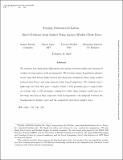Paying Outsourced Labor: Direct Evidence from Linked Temp Agency-Worker-Client Data
Author(s)
Drenik, Andres; Jäger, Simon; Plotkin, Pascuel; Schoefer, Benjamin
DownloadAccepted version (693.2Kb)
Publisher Policy
Publisher Policy
Article is made available in accordance with the publisher's policy and may be subject to US copyright law. Please refer to the publisher's site for terms of use.
Terms of use
Metadata
Show full item recordAbstract
<jats:title>Abstract</jats:title>
<jats:p>We estimate how much firms differentiate pay premia between regular and outsourced workers in temp agency work arrangements. We leverage unique Argentinian administrative data that feature links between user firms (the workplaces where temp workers perform their labor) and temp agencies (their formal employers). We estimate that a high-wage user firm that pays a regular worker a 10% premium pays a temp worker on average only a 4.9% premium, compared to what these workers would earn in a low-wage user firm in their respective work arrangements—the midpoint between the benchmarks for insiders (one) and the competitive spot-labor market (zero).</jats:p>
Date issued
2021Department
Massachusetts Institute of Technology. Department of EconomicsJournal
The Review of Economics and Statistics
Publisher
MIT Press - Journals
Citation
Drenik, Andres, Jäger, Simon, Plotkin, Pascuel and Schoefer, Benjamin. 2021. "Paying Outsourced Labor: Direct Evidence from Linked Temp Agency-Worker-Client Data." The Review of Economics and Statistics.
Version: Author's final manuscript